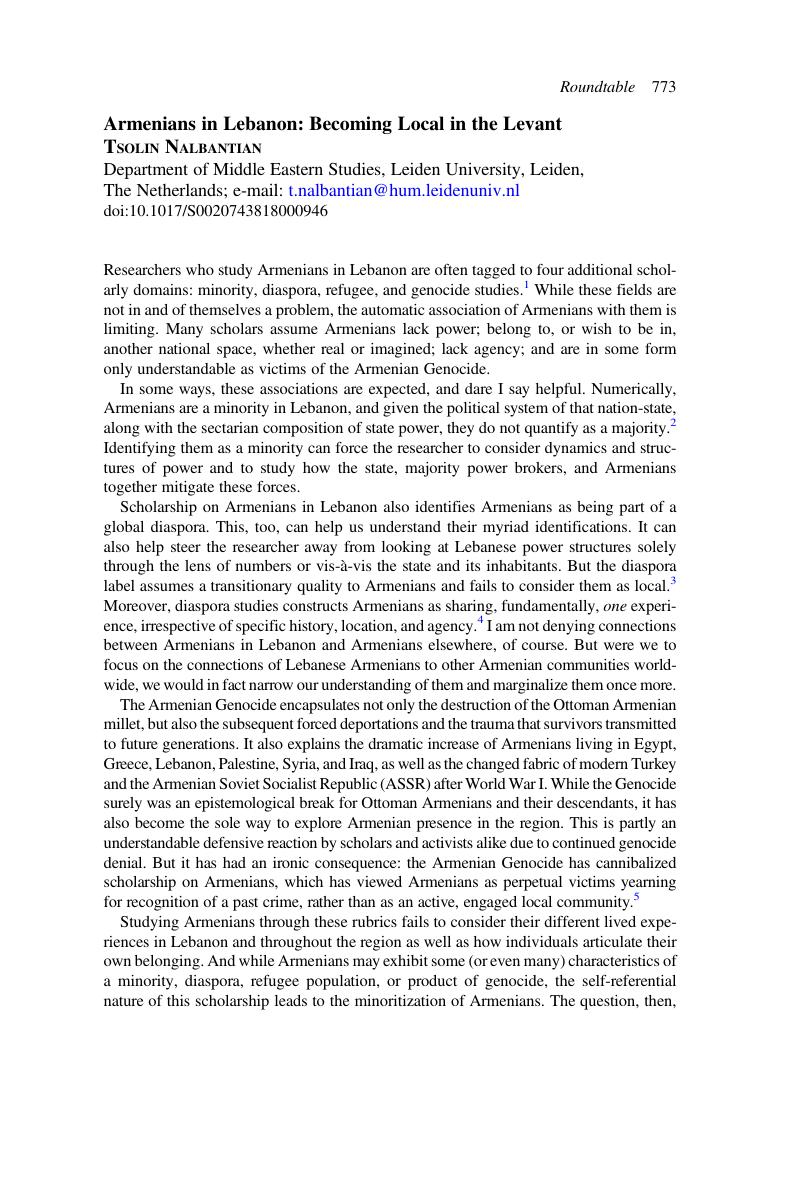Article contents
Armenians in Lebanon: Becoming Local in the Levant
Published online by Cambridge University Press: 28 November 2018
Abstract

- Type
- Roundtable
- Information
- Copyright
- Copyright © Cambridge University Press 2018
References
NOTES
1 This observation applies to researchers who work on Armenians in the Middle East more generally, but I restrict my discussion to those focused on Armenians in Lebanon.
2 For more on Armenian involvement in Lebanese politics, see Nikola B. Schahgaldian, “The Political Integration of an Immigrant Community into a Composite Society: The Armenians in Lebanon 1920–74” (PhD diss., Columbia University, 1978). On Armenians’ involvement in Lebanese parliamentary elections specifically, see Messerlian, Zaven, Armenian Participation in the Lebanese Legislative Elections 1934–2009 (Beirut: Haigazian University Press, 2013)Google Scholar. On the establishment of a Lebanese Armenian community in Lebanon and Syria, see Migliorino, Nicola, (Re)constructing Armenia in Lebanon and Syria: Ethno-Cultural Diversity and the State in the Aftermath of a Refugee Crisis (Oxford: Berghahn Books, 2008)Google Scholar.
3 An exception to this reading is the collection Diasporas of the Modern Middle East: Contextualising Community. However, the contributors continue to maintain an overarching diasporic experience amongst communities that they simultaneously identify as living in “spaces that are, in practice, their homes.” Gorman, Anthony and Kasbarian, Sossie, eds., Diasporas of the Modern Middle East: Contextualising Community (Edinburgh: University of Edinburgh Press, 2015), 2–3Google Scholar.
4 See, e.g., Cohen, Robin, Global Diasporas: An Introduction (New York: Routledge, 2008)CrossRefGoogle Scholar, in which Armenians are constructed as a category and then called a “victim diaspora.”
5 In an effort to interconnect Armenians, scholarship on Armenians stresses the totality of the Armenian Genocide. In addition, the creation of this monolith collapses different phases of extermination into a single whole, stitching together different phases of the genocide and incidents of aggression against Armenians in the Ottoman Empire. See, e.g., Kevorkian, Raymond, The Armenian Genocide: A Complete History (New York: I.B.Tauris, 2011), 71–118Google Scholar. This minimizes the experience of violence for the victims, homogenizes perpetrators, and discourages the individual examination of such events. For a notable exception to this homogenized reading, see Matossian, Bedross Der, Shattered Dreams of Revolution: From Liberty to Violence in the Late Ottoman Empire (Stanford, Calif.: Stanford University Press, 2014), 149–72Google Scholar.
6 Traboulsi, Fawwaz, The History of Modern Lebanon (London: Pluto Press, 2007), 134Google Scholar.
7 “‘National’ Salvation,” Daily Star (Beirut, Lebanon), 18 October 1958, 1; Traboulsi, History, 137.
8 This division was not new, of course. It dated back to before World War II, and was manifested in the 1946–49 repatriation and the 1956 Catholicos election of the Cilician See. But it came to a boil in 1958 because of the general Lebanese context and the accentuating right–left political polarization that at this point in time mapped roughly, though by no means fully, on to the country's Muslim-Christian confessional landscape. See Tsolin Nalbantian, Beyond Diaspora: How Armenians Made Lebanon Their Own (forthcoming).
9 These ranged from the upper middle-class neighborhoods of Zarif and Zoqat al-Blat in Ras Beirut to the lower middle- and working-class areas around St. Sarkis Patriarchate near the Serail. Armenians also resided in Furn al-Shabak and Geitawi. Outside of the center, Armenians lived in the working- and lower-class neighborhoods of Qarantina, Mar Mikael, Corniche al-Nahr, Bourj Hammoud, and Sin el-Fil. Within Qarantina, some Armenians still lived within the confines of the original Armenian refugee camp. The original camp of Sanjak, too, continued to house Armenians of more meager means; Nucho, Joanne Randa, Everyday Sectarianism in Urban Lebanon: Infrastructures, Public Services, and Power (Princeton, N.J.: Princeton University Press, 2016), 54Google Scholar.
10 Nicola Migliorino, (Re)constructing Armenia, 64–65.
11 “Moskua Mijamtets‘ Libanani Ěntrut‘iwnnerun,” Aztag (Beirut, Lebanon), 16 June 1957, 1.
12 “Vochirneru Shark‘ĕ Gĕ Sharunakui Haykakan T‘aghamaseren Ners,” Zartonk (Beirut, Lebanon), 19 November 1958, 1.
13 “Anarg Vochragortsner Gě Spannen HMEMakan Marzik Shamin ew Gě Viraworen Grigor Seraytaryaně,” Aztag (Beirut, Lebanon), 28 August 1958, 4.
14 “Hay Hamaynavarnerě Nor Zoh mě ews Khlets‘in,” Aztag (Beirut, Lebanon), 29 August 1958, 2. Armenians use the name “Hajin” for this neighborhood. They first labeled it so in the 1920s, when arriving as refugees from Hajin in South Cilicia. Arab-Lebanese use the names “Corniche al-Nahr” or “Badawi.”
15 “Eghbayraspan Ochirner Haykakan T‘agheren Ners,” 28 August 1958, 1; Kats‘ut‘unĕ Peyrut‘i Haykakan T‘agheren Ners,” Zartonk (Beirut, Lebanon), 30 August 1958, 1; “Haykakan T‘agheru Mej Kargě Verahastatelu Hamar,” Aztag (Beirut, Lebanon), 13 December 1958, 1; “Nerk‘in Nakhararhi Koch‘ě Libanahayut‘yan,” Aztag (Beirut, Lebanon), 12 December 1958, 1.
16 Ibid. Emphasis mine.
17 Ibid.
- 5
- Cited by


